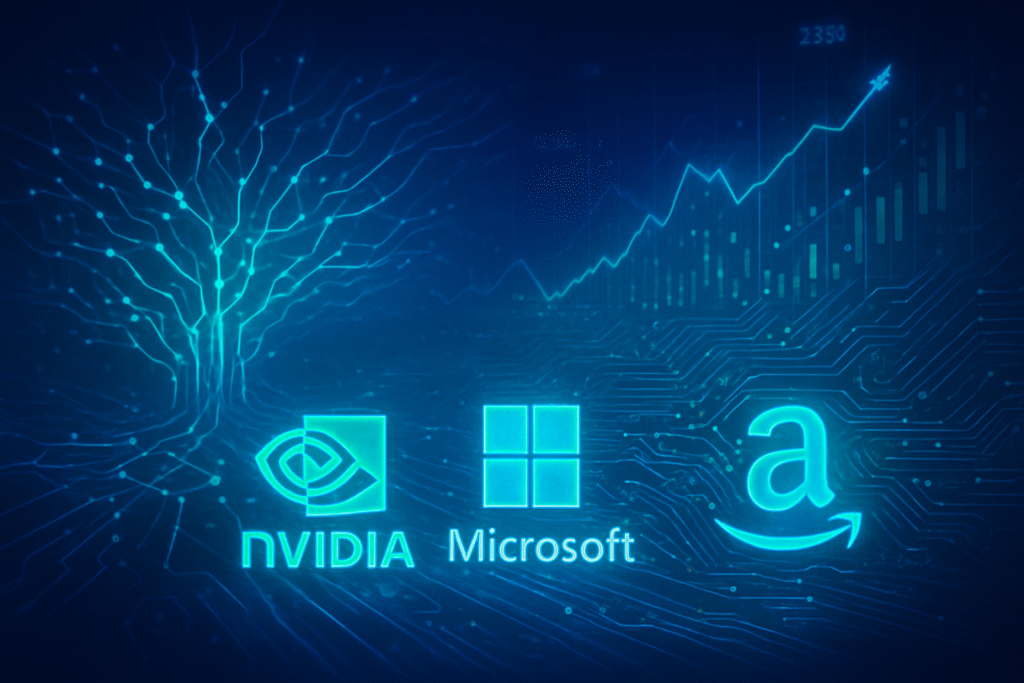
In an extraordinary display of market power, Nvidia (NASDAQ: NVDA) and a cohort of other 'Big Tech' giants have spearheaded a significant rally, providing a crucial lift to Wall Street as it navigates recent downturns. This resurgence, primarily fueled by an insatiable investor appetite for artificial intelligence (AI), has seen technology stocks dramatically outperform the broader market, solidifying AI's role as a primary catalyst for economic transformation. As of November 10, 2025, the tech sector's momentum continues to drive major indices upward, helping the market recover from recent weekly losses, even as underlying concerns about concentration and valuation persist.
The AI Engine: Detailed Market Performance and Driving Factors
Nvidia (NASDAQ: NVDA) has emerged as the undisputed titan of this tech rally, experiencing an "eye-popping" ascent fueled by the AI investing craze. From January 2024 to January 2025, Nvidia's stock returned over 240%, significantly outpacing major tech indexes. Its market capitalization milestones are staggering: crossing the $1 trillion mark in May 2023, the $2 trillion mark in March 2024, and briefly becoming the world's most valuable company in June 2024, reaching a valuation of $3.3 trillion. By late 2025, Nvidia's market capitalization has soared past $5 trillion, a testament to its pivotal role in AI infrastructure.
This explosive growth is underpinned by robust financial results and groundbreaking product announcements. For fiscal year 2025, Nvidia's revenue exceeded $88 billion, a 44% year-over-year increase, with gross margins rising to 76%. Its data center segment has been particularly strong, with revenue consistently growing quarter-over-quarter, reaching $30.8 billion in Q3 2025 and projected to jump to $41.1 billion in Q2 Fiscal 2026, accounting for nearly 88% of total revenue. Key product launches, such as the Blackwell chip architecture (unveiled in March 2024) and the subsequent Blackwell Ultra (announced in March 2025), specifically engineered for generative AI and large language models (LLMs), have reinforced Nvidia's technological leadership. The company also introduced its GeForce RTX 50-series GPUs at CES 2025, further enhancing its offerings for gaming and professional visualization.
The "Magnificent Seven" (Mag 7) — comprising Nvidia, Alphabet (NASDAQ: GOOGL), Amazon (NASDAQ: AMZN), Apple (NASDAQ: AAPL), Meta Platforms (NASDAQ: META), Microsoft (NASDAQ: MSFT),, and Tesla (NASDAQ: TSLA) — have collectively outpaced the S&P 500 (INDEXSP: .INX). By the end of 2024, this group accounted for approximately one-third of the S&P 500's total market capitalization. While Nvidia led with a 78% return year-to-date in 2024, other strong performers included Meta Platforms (NASDAQ: META) (40%) and Amazon (NASDAQ: AMZN) (15%). However, investor sentiment has not been uniformly positive; Apple (NASDAQ: AAPL) faced concerns over slowing iPhone sales, and Tesla (NASDAQ: TSLA) experienced a notable decline after surpassing a $1 trillion valuation in November 2024.
This current rally draws parallels to the dot-com bubble of the late 1990s, characterized by a transformative technology (AI now, the internet then) driving significant growth in tech stocks and an outperformance of large-cap tech. Market concentration is even higher today, with the top ten stocks comprising 39% of the S&P 500's weight, compared to 27% during the dot-com peak. However, crucial differences exist. Today's leading tech companies generally boast strong balance sheets, profitable operations, and proven business models, unlike many speculative startups of the late 1990s. Valuations, while elevated, are not as extreme, with the Nasdaq 100's forward P/E ratio significantly lower than its March 2000 peak. The current AI boom is driven by established, highly profitable companies demonstrating their ability to monetize AI through real demand and robust cash flows, suggesting a more fundamentally sound, albeit still volatile, market trend.
Reshaping the Tech Landscape: Impact on Companies and Competition
Nvidia's (NASDAQ: NVDA) market rally, driven by its near-monopoly in AI accelerators (estimated 70% to 95% market share), has profoundly reshaped the competitive landscape across the tech industry. Nvidia itself is the primary beneficiary, with its market cap soaring past $5 trillion. Beyond Nvidia, its board members, early investors, and key partners like Taiwan Semiconductor Manufacturing Co. (TSMC: TPE) and SK Hynix (KRX: 000660) have also seen substantial gains due to increased demand for their chip manufacturing and memory solutions.
Hyperscale cloud service providers (CSPs) such as Amazon Web Services (AWS), Google Cloud (NASDAQ: GOOGL), and Microsoft Azure (NASDAQ: MSFT) are significant beneficiaries as they heavily invest in Nvidia's GPUs to build their AI infrastructure. For instance, Amazon (NASDAQ: AMZN) secured a multi-billion dollar deal with OpenAI for AWS infrastructure, including hundreds of thousands of Nvidia GPUs. Their reliance on Nvidia's technology deepens, cementing Nvidia's position as a critical enabler of their AI offerings. Other AI-focused companies, like Palantir Technologies (NYSE: PLTR), have also seen significant stock jumps, benefiting from the broader AI enthusiasm.
However, Nvidia's dominance has intensified competition. Major tech firms like Advanced Micro Devices (NASDAQ: AMD) and Intel (NASDAQ: INTC) are aggressively developing their own AI chips to challenge Nvidia's lead. Furthermore, Meta Platforms (NASDAQ: META), Google (NASDAQ: GOOGL), and Microsoft (NASDAQ: MSFT) are investing in homegrown chip products to reduce their dependency on Nvidia and optimize solutions for their specific AI workloads. Custom chips are projected to capture over 40% of the AI chip market by 2030, posing a significant long-term disruption to Nvidia's market share. Nvidia's proprietary CUDA software platform creates a formidable ecosystem that "locks in" customers, forming a significant barrier to entry for competitors. However, the increasing importance of software innovation in AI chips and the shift towards integrated software solutions could reduce dependency on any single hardware provider.
The AI advancements are driving significant disruption across various sectors. Nvidia's powerful hardware is democratizing advanced AI capabilities, allowing industries from healthcare to finance to implement sophisticated AI solutions. The demand for AI training and inference is driving a massive capital expenditure cycle in data centers and cloud infrastructure, fundamentally transforming how businesses operate. Nvidia is also transitioning into a full-stack technology provider, offering enterprise-grade AI software suites and platforms like DGX systems and Omniverse, establishing industry standards and creating recurring revenue through subscription models. This ecosystem approach disrupts traditional hardware-only models.
Broader Significance: AI's Transformative Role and Emerging Concerns
The Nvidia-led tech rally signifies AI's undeniable role as a General-Purpose Technology (GPT), poised to fundamentally remake economies, akin to the steam engine or the internet. Its widespread applicability spans every industry and business function, fostering significant innovation. Global private AI investment reached a record $252.3 billion in 2024, with generative AI funding soaring to $33.9 billion, an 8.5-fold increase from 2022. This investment race is concentrated among a few tech giants, particularly OpenAI, Nvidia (NASDAQ: NVDA), and hyperscalers like Google (NASDAQ: GOOGL), Amazon (NASDAQ: AMZN), and Microsoft (NASDAQ: MSFT), with a substantial portion directed towards building robust AI infrastructure.
AI is driving shifts in software, becoming a required layer in Software-as-a-Service (SaaS) platforms and leading to the emergence of "copilots" across various business departments. New AI-native applications are appearing in productivity, health, finance, and entertainment, creating entirely new software categories. Beyond the core tech sector, AI has the potential to boost productivity and economic growth across all sectors by increasing efficiency, improving decision-making, and enabling new products and services. However, it also poses a disruptive effect on the labor market, potentially displacing jobs through automation while creating new ones in technology and healthcare, which could exacerbate income inequality. The expansion of data centers to support AI models also raises concerns about energy consumption and environmental impact, with major tech players already securing nuclear energy agreements.
The current market rally is marked by a historically high concentration of market value in a few large-cap technology stocks, particularly the "Magnificent Seven," which account for a significant portion of major indices. This concentration poses a "concentration risk" for investors. While valuations are elevated and considered "frothy" by some, many leading tech companies demonstrate strong fundamentals and profitability. Nevertheless, persistent concerns about an "AI bubble" are growing, with some analysts warning that the boom might not deliver anticipated financial returns. The Bank of England and the International Monetary Fund issued warnings in October and November 2025 about the increasing risk of a sharp market correction in tech stocks, noting that valuations are "comparable to the peak" of the 2000 dot-com bubble.
Comparing this rally to the dot-com bubble reveals both similarities and crucial differences. Both periods are centered around a revolutionary technology and saw rapid valuation growth and market concentration. However, today's dominant tech companies possess strong underlying fundamentals, generating substantial free cash flows and funding much of their AI investment internally. Valuations, while high, are generally lower than the extreme levels seen during the dot-com peak. The current AI rally is underpinned by tangible earnings growth and real demand for AI applications and infrastructure, rather than pure speculation.
The Road Ahead: Future Developments and Expert Predictions
In the near term (late 2025 – 2027), Nvidia (NASDAQ: NVDA) is poised for continued strong performance, primarily driven by its dominance in AI hardware. The Blackwell GPU line (B100, B200, GB200 Superchip) is in full production and expected to be a primary revenue driver through 2025, with the Rubin architecture slated for initial shipments in 2026. The data center segment remains a major focus due to increasing demand from hyperscale cloud providers. Nvidia is also expanding beyond pure GPU sales into comprehensive AI platforms, networking, and the construction of "AI factories," such as the "Stargate Project" with OpenAI.
Long-term, Nvidia aims to solidify its position as a foundational layer for the entire AI ecosystem, providing full-stack AI solutions, AI-as-a-service, and specialized AI cloud offerings. The company is strategically diversifying into autonomous vehicles (NVIDIA DRIVE platform), professional visualization, healthcare, finance, edge computing, and telecommunications. Deeper dives into robotics and edge AI are expected, leveraging Nvidia's GPU technology and AI expertise. These technologies are unlocking a vast array of applications, including advanced generative AI and LLMs, AI-powered genomics analysis, intelligent diagnostic imaging, biomolecular foundation models, real-time AI reasoning in robotics, and accelerating scientific research and climate modeling.
Despite its strong position, Nvidia and the broader AI market face significant challenges. Intensifying competition from AMD (NASDAQ: AMD), Intel (NASDAQ: INTC), and hyperscale cloud providers developing custom AI chips is a major threat. Concerns about market saturation and cyclicality in the AI training market, with some analysts suggesting a tapering off of demand within the next 18 months, also loom. Geopolitical tensions and U.S. trade restrictions on advanced chip sales to China pose a significant challenge, impacting Nvidia's growth in a market estimated at $50 billion annually. Valuation concerns and the substantial energy consumption required by AI also need to be addressed.
Experts largely maintain a bullish outlook on Nvidia's future, while acknowledging potential market recalibrations. Analysts have a consensus "Strong Buy" rating for Nvidia, with average 12-month price targets suggesting an 11-25% increase from current levels as of November 2025. Some long-term predictions for 2030 place Nvidia's stock around $920.09 per share. The AI-driven market rally is expected to extend into 2026, with substantial capital expenditures from Big Tech validating the bullish AI thesis. The AI narrative is broadening beyond semiconductor companies and cloud providers to encompass sectors like healthcare, finance, and industrial automation, indicating a more diffuse impact across industries. The lasting impact is expected to be an acceleration of digital transformation, with AI becoming a foundational technology for future economic growth and productivity gains.
Final Thoughts: A New Era of AI-Driven Growth
The Nvidia (NASDAQ: NVDA) and Big Tech market rally represents a pivotal moment in recent financial history, marking a new era where AI is the undisputed engine of economic growth and technological advancement. Key takeaways underscore AI as the central market driver, Nvidia's unparalleled dominance as an AI infrastructure provider, and the increasing market concentration among a few tech giants. While valuation concerns and "AI bubble" debates persist, the strong underlying fundamentals and profitability of these leading companies differentiate the current rally from past speculative booms.
The long-term impact on the tech industry and Wall Street is expected to be profound, characterized by a sustained AI investment cycle, Nvidia's enduring influence, and accelerated AI adoption across virtually all industries. This period will reshape investment strategies, prioritizing companies with robust AI integration and growth narratives, potentially creating a persistent divide between AI leaders and laggards.
In the coming weeks and months, investors and industry observers should closely monitor Nvidia's Q3 earnings report (expected around November 19, 2025) for insights into demand and future revenue prospects. Continued aggressive capital expenditure announcements from Big Tech, macroeconomic and geopolitical developments (especially regarding U.S.-China chip trade), and broader enterprise AI adoption trends will also be crucial indicators. Vigilance for signs of excessive speculation or "valuation fatigue" will be necessary to navigate this dynamic and transformative period. This AI-driven surge is not merely a market rally; it is a fundamental reordering of the technological and economic landscape, with far-reaching implications for innovation, productivity, and global competition.
This content is intended for informational purposes only and represents analysis of current AI developments.
TokenRing AI delivers enterprise-grade solutions for multi-agent AI workflow orchestration, AI-powered development tools, and seamless remote collaboration platforms.
For more information, visit https://www.tokenring.ai/.






